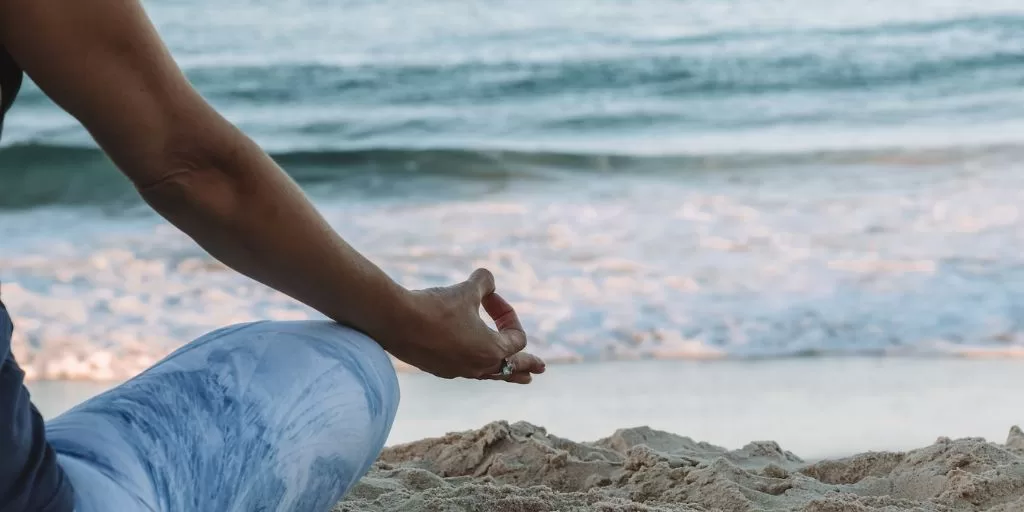Meditation is a powerful practice that can help people to achieve greater mental clarity, relaxation, and well-being. It has been shown in numerous studies to have profound benefits for physical health and emotional balance. For those who are interested in beginning meditation training, it is important to understand the basics of this ancient practice. This article will provide an introduction to the fundamentals of meditation training and offer guidance on how best to start the journey toward finding inner peace and contentment through mindful contemplation.
The first step in learning how to meditate is understanding what it is and where it originated from. Meditation is an age-old spiritual discipline with roots tracing back thousands of years throughout Eastern philosophies such as Buddhism, Hinduism, Taoism, Kabbalah, and Sufism. It typically involves sitting quietly while paying attention to breathing or mantra repetition in order to focus the mind away from distractions and cultivate deeper states of awareness. The purpose of meditation training is usually not only to relax the body but also still the mind so that practitioners may gain insight into their true nature beyond thought patterns or emotions.
In addition to developing greater self-awareness, regular mindfulness sessions can promote improved concentration skills which can be beneficial both in personal endeavors as well as professional pursuits. Aspiring meditators should set aside time each day for their own practice; creating a consistent routine allows them to make more efficient use of each session by allowing themselves ample opportunity for introspection without having wasted energy working against distraction caused by lack of preparation or commitment beforehand. With these steps taken care of, one can begin on the path toward mastering the art of mindfulness through dedicated meditation training!
Table of Contents
- 1 Definition Of Meditation
- 2 Benefits Of Meditation
- 3 Preparing For Meditation
- 4 Setting A Regular Practice Schedule
- 5 Establishing A Comfortable Environment
- 6 Posture And Breathwork Basics
- 7 Techniques To Focus The Mind
- 8 Guided Meditations
- 9 Working With Difficult Emotions
- 10 Integrating Meditation Into Daily Life
- 11 Conclusion
Definition Of Meditation
Meditation is a practice of focused concentration that enables one to gain insight into the nature of reality. It involves contemplation and reflection on various topics, such as personal thoughts or feelings, belief systems, spiritual states, or physical sensations. Through meditation, individuals are able to achieve a state of mental clarity and relaxation.
The term “meditation” originates from the Latin “meditari” which means “to think” or “consider”. This is an apt description for this ancient practice which has been used by different cultures throughout history in order to explore the inner realms of consciousness. Meditation can be practiced in many forms, including visualization, chanting mantras, or silent inward reflections.
Regardless of its form, the purpose of meditation remains consistent: To attain greater awareness and understanding of oneself and their surroundings while cultivating peace and tranquility within oneself. By developing mindful observation through regular practice, practitioners can become more alert to internal experiences as well as external happenings around them.
Being aware of how our minds work helps us make better decisions in life; it also gives us a chance to detach ourselves from any negativity we may encounter in our daily lives. With sustained practice over time, those who meditate often report experiencing deeper levels of contentment and happiness than they had prior to beginning meditation training.
Benefits Of Meditation
Various benefits of meditation have been documented by numerous studies throughout the years. Meditation has become a popular practice for many people due to its potential health and mental benefits, such as enhancing mental clarity, relieving stress, boosting creativity, and helping with better sleep.
Meditation can help improve your overall wellness through reduced stress levels. It has been proven that regular meditation helps reduce feelings of anxiety and depression. Stress reduction is beneficial in preventing physical illnesses caused by high cortisol levels associated with long-term stress. Additionally, it allows you to take time out from everyday life so that you can gain perspective on situations and be more aware of yourself and the others around you.
Meditating regularly also helps sharpen focus, increase attention span, and boost productivity, as well as memory recall. Engaging in mindful activities during or after meditating can heighten creative problem-solving skills which could lead to improved decision-making processes when facing complicated issues. Being able to think clearly enables one to make sound judgments while eliminating distractions that may interfere with their thought process over time.
Furthermore, quality sleep is essential for good health both physically and mentally; however, insomnia is a common issue among adults today leading to fatigue, exhaustion, irritability, and poor concentration among other symptoms. Meditation techniques such as deep breathing exercises before bedtime can relax the mind allowing you to drift off into peaceful slumber without difficulty each night. In addition to relaxation methods practiced before sleeping, research suggests meditating daily increases the amount of restful sleep resulting in an energized feeling upon waking up each morning.
Overall, incorporating even just 10 minutes of meditation into your day will provide significant positive results including increased mental clarity, relief from stressors of everyday life, enhanced creativity, as well as improved quality of sleep. Therefore, dedicating some time to this practice could potentially offer profound changes in a short period of time if done consistently over time.
Preparing For Meditation

The journey to meditation begins with preparation. Taking time before meditating to ensure that you are adequately prepared is essential for a successful practice. Meditation readiness requires setting up an environment conducive to relaxation and focusing on your inner world. To jumpstart your meditation training, it’s important to understand the basics of creating a productive and peaceful space for yourself.
Creating a comfortable and safe physical environment can help provide mental clarity during the process. Consider factors such as lighting, temperature, noise level, seating option, and other objects within view when deciding where to meditate. For instance, if possible find a place away from distractions or too much stimulation in order to create an atmosphere of peace and serenity. If indoors isn’t ideal, try taking your practice outdoors in nature – soaking up natural light can be incredibly calming!
Focusing on comfortability will also support success while practicing meditation skillset. Choose clothing that allows freedom of movement; maintain proper posture by sitting upright but relaxed; use props such as cushions or blankets to keep back straight without strain; make sure hands rest comfortably either on lap or floor depending on position chosen; select what type of music (if any) helps direct attention inward rather than outwardly distracting; all these choices contribute toward maximizing potential outcomes from every session.
Finally, start each practice with intentionality – have a clear idea about why you choose to meditate at this moment and set goals accordingly prior to beginning meditative exercises so that motivations stay steady throughout the duration of practice despite changes in thoughts or feelings that might occur naturally along the way. By following these key components of meditation preparation one can easily become ready for their next mind-body exploration experience!
Setting A Regular Practice Schedule
Establishing a regular practice schedule for meditation is an important step for achieving success with the training. Time management is essential and those who plan ahead can ensure that they make time each day to dedicate to their mindful moments. Consistency in the schedule will help create progress, as well as allow for more awareness of how one’s body and mind are responding to the techniques being used.
The first step toward building a successful meditation routine is identifying when it will take place. Consider whether mornings or evenings work better for you, as this may depend on your daily schedule and lifestyle habits. It is also helpful to decide if you would prefer longer or shorter sessions during the day, such as 60 minutes versus 10 minutes. Moreover, having particular days set aside where one devotes extra time can be beneficial too; some people find Thursdays work best or Sundays offer them greater relaxation.
Once a suitable time has been decided upon, it is key to stick with it every single day even if there are obstacles along the way. If something comes up which means that one cannot meditate at their usual hour then consider other times later in the day where possible. By being flexible yet committed one can continue with their routine while still managing any commitments life throws at them.
In addition to setting out specific times for practice, creating reminders can aid further in establishing a consistent routine. A reminder could take shape through writing down goals, adding notifications onto phones, or using alarms – whatever works best for individual needs! Doing so helps us stay accountable and motivated throughout our journey into meditation training.
Establishing A Comfortable Environment

Having established a regular practice schedule, the next step in preparing for meditation training is to create an environment that is comfortable and conducive to relaxation. To do this, it is advisable to set aside a dedicated space for one’s meditation practice. This designated “meditation space” should be chosen carefully as it will become an important part of the individual’s daily routine.
The setting should also provide ideal conditions for calming and focusing the mind such as minimal distractions from noise or interruptions. It can be useful to introduce items into the area which are tranquilizing and evoke peace such as soft lighting, calming music, and soothing scents like lavender or incense. This helps establish a mindful atmosphere that encourages stillness and reflection during one’s sessions.
It may also be beneficial to have some basic equipment on hand such as cushions, Yoga mats, or blankets depending on what type of posture will be adopted during meditation practice. Additionally, having access to resources related to meditation techniques could prove helpful when addressing questions or concerns regarding different aspects of mindfulness.
Creating an inviting ambiance with these elements enables meditators to enter their practice in a relaxed state while providing them with everything they need both physically and mentally throughout their journey. When done correctly, this leads meditators toward developing greater awareness of their inner selves through focused attention on body sensations, thoughts, and feelings thereby achieving true tranquility within themselves.
Posture And Breathwork Basics
Posture is an important aspect of meditation training. To begin, the practitioner should find a comfortable and supportive seat that will facilitate relaxation during the practice. It may be helpful to sit on a cushion or bolster for additional support. Sitting in a chair with feet firmly planted on the floor is also acceptable. The most important element of posture for meditation is maintaining neutrality and stillness, allowing the body to remain relaxed while using only as much effort as necessary to maintain upright alignment.
The breathwork basics of meditative breathing involve focusing attention on one’s natural inhalations and exhalations without making any changes or alterations. This type of mindful breathing helps reduce stress levels while preparing the mind and body for deeper states of concentration. It can be beneficial to focus awareness on the sensation of air passing through the nostrils, mouth, or throat area during each breath cycle. A gentle reminder to stay connected with this sensation throughout the session can help keep distractions at bay.
In addition, incorporating visualization techniques such as imagining oneself inhaling fresh energy and exhaling tension can further deepen relaxation by helping build mindfulness skills over time. Creating specific intention statements before beginning each practice can aid in setting mental intentions for what one wishes to achieve from their session.
Meditation basics include cultivating non-judgmental awareness toward both self and environment which allows space for growth within the individual’s inner landscape. Allowing thoughts to come and go naturally rather than attempting to control them encourages greater acceptance of changeable experiences over time. With consistent practice, it ultimately becomes easier to gently return focus back onto chosen objects like breath whenever they begin to drift away from the present moment experience.
Techniques To Focus The Mind
Focusing the mind is an essential aspect of meditation training, as it helps to bring mental clarity and mindfulness. Approximately, 200 to 500 million people meditate globally. Focusing the mind requires regular practice and mental discipline; however, with time and effort, it can be achieved.
To begin focusing the mind during meditation, one should start off with simple concentration exercises such as counting breaths or repeating mantras. Counting breath can help to center the attention on the rise and fall of each inhalation and exhalation; while repeat mantras are short phrases repeated either out loud or internally that can help create a sense of calmness. Awareness techniques may also be used in which one focuses on physical sensations without judgment or attachment.
In order to maintain focus during meditation, practice sessions must be done consistently and preferably for at least 10 minutes every day. Over time this will gradually increase your ability to concentrate on one thing over longer periods of time. It’s important not to become frustrated when thoughts occur but rather notice them and then intentionally refocus back onto what you were doing before being distracted. As mastering focus takes patience and dedication, remember there is no wrong way to meditate so enjoy the journey!
Practicing these techniques regularly will encourage greater mental clarity and allow for deeper insight into one’s inner world; leading to personal transformation along with improved overall well-being. Therefore, investing time daily into focusing practices can unleash numerous benefits both inwardly and outwardly within our lives.
Guided Meditations
Guided meditations are a powerful tool for developing a successful long-term practice of meditation and achieving desired outcomes. Guided meditations provide an external structure to help the practitioner focus attention, regulate breathing, and relax into a state conducive to meditation. In guided meditations, verbal instruction is offered by the instructor or trainer in order to guide inwardly and direct awareness toward deeper states of relaxation. This can be done by using visualizations, mantras, body scans, breathwork, and other techniques.
The main advantage of guided meditations is that they allow beginners with little or no experience in meditation to quickly gain familiarity with different meditation practices while being supported by instructions given during the session. Experienced practitioners also benefit from this type of meditation practice as it gives them an opportunity to explore new directions in their practice without having to rely on self-guidance alone.
In addition to providing guidance throughout each practice session, some teachers may also offer detailed explanations about particular aspects of the technique such as postures used in specific types of meditation or how best to use breathwork for certain goals. By learning these details and understanding the purpose behind various practices one can become more proficient at applying them correctly when engaging in solo meditation sessions later on.
Ultimately guided meditations provide both novice and experienced meditators alike with an effective means of transitioning into deeper states of consciousness while staying connected with external support. With regular training and repetition, over time guided meditations will enable individuals to acquire sufficient skills needed for establishing a successful long-term personal practice which can result in improved mental clarity and physical well-being.
Working With Difficult Emotions
When engaging in meditation practice, it is important to be aware of difficult emotions and emotional triggers that can arise. Difficult emotions such as anger or fear may present themselves during the course of meditation training, often due to being confronted with uncomfortable thoughts, images, or memories. It is essential for practitioners to remain mindful of their body sensations and mental processes throughout this process so they can develop an understanding of how to work with difficult emotions effectively within their own practice.
It is also helpful to observe these emotions without judgment or attachment. By developing a compassionate attitude toward one’s self during moments of distress, one will be better able to create space between oneself and the emotion so that any feelings associated with the experience do not become overwhelming. Allowing yourself to simply witness emotion, rather than react from it, creates an opportunity for more skillful responses when dealing with difficult feelings.
The next step involves exploring what lies beneath the surface of these challenging emotions. Paying attention to subtle shifts in energy that accompany each emotion helps move us beyond our habitual reactions into a deeper level of awareness about ourselves and our relationship with others. Through this exploration, we can begin to recognize patterns in order to gain clarity on any underlying issues that might contribute to our feeling states.
Learning how to identify and honor our emotional experiences provides an invaluable tool for navigating through life’s ups and downs while cultivating greater acceptance and inner peace along the way. Cultivating mindfulness around our emotional states over time allows us to choose wiser actions in response to difficult situations and thereby access growth opportunities presented by them.
Integrating Meditation Into Daily Life
Once a person has worked with difficult emotions and developed some skill in managing them, they may wish to explore incorporating meditation into their lifestyle. Establishing a daily meditation practice is typically the first step toward this goal. A regular meditation routine will provide consistency and structure to an individual’s life while also helping to reduce stress levels and cultivate mindful approaches.
When beginning a daily meditation practice it is important that one starts gradually and not become overwhelmed by its demands. It can be helpful to set aside 10 minutes or so each day for the purpose of meditating. After establishing this initial foundation, one can then choose either to continue on at this level or begin increasing the amount of time devoted to meditation as desired.
While developing an internal discipline is crucial for any successful exploration into meditation, there are also several external factors that can help facilitate the integration of meditation into everyday life. Environments conducive to relaxation such as natural settings or peaceful locations inside the home should be sought out whenever possible in order to create optimum conditions for cultivating a healthy attitude toward one’s own personal well-being. Also, having access to resources like books, online articles, podcasts, and other media about the subject matter can assist significantly when encountering difficulties along the way.
As an individual continues engaging in regular meditation practices over time they may come to find that it becomes second nature in terms of how they interact within both their inner and outer worlds; thus allowing them fully embody what it means to have integrated a dedicated meditation lifestyle into all aspects of their lives.
Conclusion

Meditation is a powerful tool that can help us gain insight into our lives and tap into the wisdom within ourselves. Practicing meditation regularly has been proven to reduce stress, improve focus and concentration, and increase feelings of well-being. It can also be used as part of a holistic approach to mental health care and self-care. With dedication and practice, anyone can learn how to meditate and experience its many benefits.
Anyone interested in beginning or deepening their own meditation practice should take time to research different techniques, find good resources for guidance, create a comfortable environment for practicing daily, establish a convenient schedule for themselves, and remain mindful during any difficulty they may encounter along the way. Dedicating yourself to exploring your inner world through meditation will strengthen your connection with yourself while providing you with invaluable tools for improving your life quality each day.




